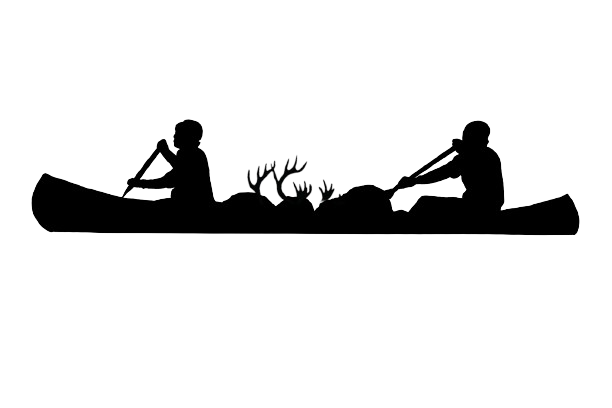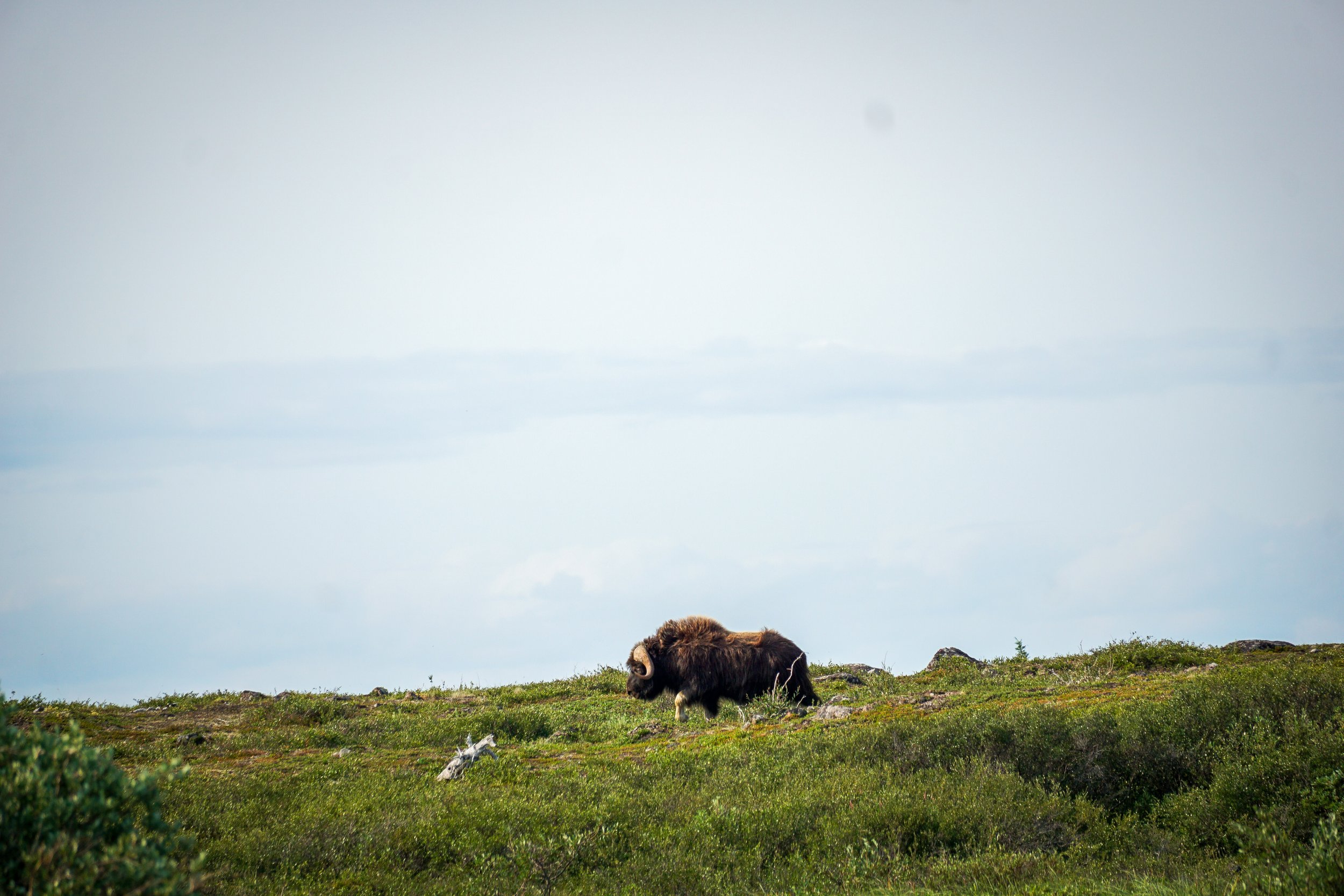Reflections - Wildlife
Cow & calf moose in the "little lakes" area of our route.
It has been a few weeks now since we have returned home from our expedition and it has been a lot of fun sorting through our photos, videos, and stories from the past few months. As I (Zach) have gone through pictures in particular, I can’t help but reflect on the abundance of wildlife we were so lucky to encounter throughout the course of our route.
Our route passed through such a diverse swath of ecosystems and with that, a huge variety of wildlife was abundant to us. We were fortunate enough to have great wildlife encounters since day one. Not even a few hours from when we pushed off in northern Minnesota, we were able to watch a black bear swim across the river right in front of us as we paddled by. A few hours later, in our first camp, we had a pair of beavers who seemed unafraid come right up to our camp and we were able to watch them eat sticks, carry mud, and wash themselves. This seemed to pave the way for good wildlife viewing for the months to come.
Two beavers in our camp on day one of the expedition.
Since there was only two of us, we were able to travel these waterways pretty quietly and likely contributed to our success seeing so much wildlife. In the lower half of our route, we had quite a few black bear sightings, usually every couple of days we saw them. Typically, they were walking the shorelines, paying no attention to us, which allowed us to stop paddling for a bit and watch. One day on the Winnipeg River, we saw a group of four black bears together eating along the beach, which seemed like a pretty rare encounter we were pleased to come by. About 3 km later, we came across another solo black bear seeing 5 on that one day. One of the last days we spent on Lake Winnipeg, we had our closest black bear encounter, but I think that story is best saved for a future blog…




One animal we were looking forward to seeing through most of the route was the moose. We paddled through a lot of great moose habitat on smaller rivers, creeks, and wetlands and expected to see them pretty regularly. However, as we got within a few days of the tundra, we still hadn’t seen a single moose, over 60 some odd days into our trip. We joked that we were going to paddle across the entire mainland of Canada and not see a single moose, one of its most iconic species. We were very happy, however, that was not the case for us. As the trees began to spread out and we entered the land of “little sticks”, we finally saw our first moose eating in the water on a warm day. Unconcerned as to what we were, we floated by as it chewed the vegetation from the water below. It seemed as though we just needed to get our first moose sighting out of the way. In the days that followed, we saw them just about every day leading up to the tundra, some days we saw three or more!
Bull moose in velvet in the "little lakes" area.
With the change in scenery as we paddled into the tundra, with it came a change in wildlife. Caribou became a very regular sighting along the river banks, swimming across channels, or walking the hilltops around the river. There were several times that we saw lone caribou, not yet in the big herds for their annual migration. Other days, we saw much bigger groups and traveling together. On at least one day, we saw several hundred throughout the course of the day, some other days also close to a hundred or so.
Lone caribou walking the shoreline.
One day on Dubawnt Lake, we were approaching an island that looked promising for camp for the night. Upon getting closer, we saw a lone caribou running up and down its shore. We ended up camping on the opposite end of the island from where we saw it. As I was setting up the tent and Taylor was cooking dinner, that same caribou came running into our camp along the shore. It saw us and smelled us, but paid no attention. Taylor was using the canoe as a wind block for cooking not far off the shore and the caribou ended up running just a few feet from him as we watched it pass by (check out the video of it on our Instagram). The caribou bedded down about 80 yards away from our camp in some low bushes and stayed there for most of the evening.
Screenshot from video of caribou walking through camp - check out the video on our Instagram page.
Another night on Meadowbank River, we again had a lone caribou walk into our camp and came within a few feet from us again while we were cooking (this one was also very aware of us). We must not hold a very threatening look because this caribou not only walked a few feet away from us, but also bedded down a few feet from us and our tent while we ate our dinner. Unfortunately, our cameras were under the tent and were unable to get a photo of it, but nonetheless a super cool experience. The Meadowbank also provided us the most surreal wildlife encounter either of us had seen between a pack of arctic wolves and some caribou. To do the story justice, it will be the topic of a future blog.
Caribou walking the hillside along an arctic river.
Aside from the caribou, we did see quite a few muskox scattered throughout the arctic. They were not nearly as common along our route as the caribou, but still relatively abundant. A few times on some portages and smaller rivers, we got a bit closer to some lone muskox grazing. On one particular day later in the trip, we were able to see a herd of at least 30 muskox walking along the rivers edge. Sporadically, they burst into sprints and the herd moved along the shore in one big dark mass.
Bull muskox along an unnamed river in the arctic.
A constant that we encountered throughout the whole route was the waterfowl and birds. As we progressed north, the species of ducks and loons particularly changed. We saw many mallards, teal, wood ducks, mergansers, and a lot of geese and swans too. Getting closer to the ocean, there were many birds that migrate to this part of the north for breeding and then make the long migration south. A lot of geese, cranes, and Ross/snow geese. The ross and snow geese were particularly plentiful on the coast itself and surrounded the hillsides of our last campsite.
Ptarmigan near our camp in the arctic.
We feel so blessed to have had so many up close and personal experiences with these animals throughout our route and even get a few photos as memories along the way. What a feeling it is to be an observer in these landscapes where the animals are still able to roam free and wild, some of which have never seen a human or been impacted by our development in their lives. It is truly a unique experience I hope everyone is able to have sometime in their lives. However, as these open and untouched spaces are becoming less and less common, it is equally important that we carry the responsibility of keeping these places wild as they are so the future generations will have the opportunity to have a similar experience.
Keep an eye out for more blogs coming soon to hear more stories from the expedition, along with photos and videos!








